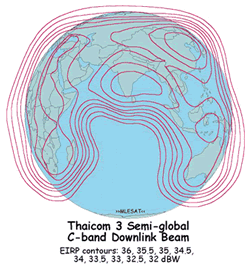
The broadcasts of the THAICOM communications satellite
(source: the company’s website, www.mlesat.com)
1. In early January 2008, Hezbollah’s Al-Manar channel could be received via THAICOM, a Thai communications satellite. Broadcasting primarily to South-East Asian countries, the satellite nevertheless covers a much larger area and can be received, as the company claims, in most Asian countries, in parts of Australia, in Africa, the Middle East, and Central Europe (see chart on the cover page). Using the new satellite, Al-Manar’s broadcasts significantly increase the impact of Hezbollah’s incitement against Israel , the Jewish people, and the US across the Muslim world and among non-Muslim target audiences.
2. In recent years, Al-Manar’s broadcasting worldwide was significantly curbed following the global campaign to delegitimize the broadcasts and the legal actions to stop the channel’s broadcasts, taken by the US and by European countries. Within this context, the operations of the communications satellite Asiasat, which broadcasted the channel via satellite to Asian countries, were terminated in August 2005. In addition, limitations were imposed on the channel’s broadcasting in the US , Europe, and South America . 1
3. As a result of the preventive measures taken by the international community, in the past two years Al-Manar has been broadcasting only via Arab communications satellites, a fact which diminished its distribution. The satellite companies through which the channel was broadcasted are Nilesat, an Egyptian-owned satellite television company which broadcasts to the Middle East and North Africa and can also be received in some South European countries; and Arabsat, an inter-Arab satellite communications company which broadcasts to the Middle East and North Africa, and can also be received in some European countries (a third of its shares are owned by Saudi Arabia). Hezbollah’s current use of the Thai communications satellite allows the organization to restore some of its damaged broadcasting capabilities and expand its broadcast range to many countries which could not receive its broadcasts before.
THAICOM’s preliminary response
4. Following the Information Center ‘s report (Hebrew version), THAICOM was approached by "The Media Line" website 2 regarding Al-Manar’s broadcasts. THAICOM avoided formal response, stating "it is considering its response and will only offer a formal reaction over the weekend”. However, "company sources” said "the decision to transmit Al-Manar broadcasts was a ‘purely business decision which had nothing to do with politics’”. The sources added that "THAICOM considers Al-Manar programming as ‘news and entertainment’”. 3
Appendix
Details about the company which provides satellite services to the Al-Manar TV channel
5. The owner of the satellite is Shinawatra Computer and Communications Co. Ltd., a private communications company operating in Thailand . In 1991, the company received a license from the Thai Transportation and Communications Ministry to operate communications satellites for the Thai government for a period of thirty years. After receiving the license, the company signed a 100-million-dollar contract with Hughes Space and Communications Company, which provided it with space equipment, terrestrial equipment, training, and supervision of the satellites. The system was named THAICOM by the King of Thailand, symbolizing Thailand ‘s commitment to modern communications technology.
6. The company’s first communications satellite was launched in December 1993, the second in October 1994, and the third in April 1997. According to the company, the launch of the third satellite allows it to provide international services across an extensive territory, covering East Asia, Central Europe, Africa, the Middle East, and Australia .
Technical information on the communications satellite
(from the company’s website, www.mlesat.com)
|
Launch dates: |
|
|
Current orbital locations: |
|
|
Mission Lifetime: |
13.5 years |
|
Contractors: |
|
|
Platform: |
Lightweight version of Hughes HS-376 spin stabilised |
|
Dimensions: |
2.16 meters in diameter, 6.6 m in height with solar array drum extended |
|
C-band Transponders: |
Ten plus two transponders backup; 11-watt solid state power amplifiers |
|
C-band Transponder bandwidth: |
36 MHz |
|
Ku-band Transponders: |
Two plus one transponder backup: 47-watt travelling wave tube amplifiers |
|
Ku-band Transponder bandwidth: |
54 MHz |
1 The Intelligence and Terrorism Information Center has been following this process from its very beginning. For example, see our Information Bulletins: "Further limitations on Al-Manar broadcasts: The Spanish government ordered the banning of Hezbollah TV station’s broadcasts to Latin America via its satellite company, Hispasat” (July 11, 2005); "Another limitation placed by the international community on broadcasts emanating from Hezbollah’s Al-Manar TV station” (March 29, 2006).
2 www.themedialine.org.
3 "Millions Receive Hizbullah TV Via Thai Satellite”, Yaniv Berman, The Media Line website, January 10, 2008 ( http://www.themedialine.org/news/news_detail.asp?newsid=20184 ).







